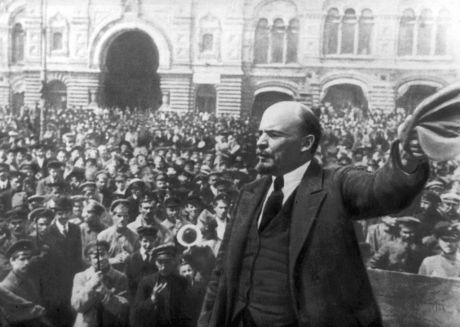Arts
You are here
Tsar to Lenin

March 29, 2013
P { margin-bottom: 0.08in; }
Tsar to Lenin is an astonishing record of the Russian Revolution of 1917. It is made completely of footage recovered in the 1920s and 1930s of the events before and during the revolution and subsequent civil war. The Russian Revolution was the first of the worlds' great revolutions where audio and video technology existed to record events. You can see some events of the revolution in this film, and if you poke around the internet you can find audio recordings of a speech or two by Lenin and Trotsky.
The movie starts with coverage of the Tsar and his family, including a scene of the the Tsar and his court skinny dipping in a lake. Immediately we are shown pictures of ordinary Russians living in the poverty of early twentieth century Russia. Then into the trenches of the first world war. The war and poverty make clear the need to depose the Tsar while trying to build a society run by the majority.
The mass demonstrations that made up the revolution are wonderful to behold. There is a great scene of Russians in support of the revolution marching with rifle and bayonet on their shoulders, and when you look closer you realize they are all in civilian clothes. This is the working class of Petrograd armed in defense of their revolution.
The coverage of the civil war shows the horrors inflicted on the world's first workers' state by external invasion and internal support of the old order.
This footage was recovered by Herman Axelbank who made the film. The narration is provide by Max Eastman, an American radical, who, among other things, translated Trotsky's definitive History of the Russian Revolution into English. Originally released in 1937 the movie has been almost impossible to see since then.
Immediately after it's premier in 1937 the Stalinist Russian government and the American Communist party began to try to stop it from being shown. The movie, truthfully, shows Trotsky's great importance to the revolution and leadership in building the Red Army that was able to win the civil war. Also, despite their efforts, Eastman and Axelbank could not find any film of Stalin during the revolution. Presumably because nobody thought he was important enough to film. Showing the relative importance of Stalin and Trotsky to the revolution was too much for Stalin to bear. The American Communist party newspapers called for a boycott of the the theatre showing the movie. Behind the scenes the Russian government threatened American movie distributors that if Tsar to Lenin continued to be shown, they would not allow Russian films, especially those of the very popular Sergei Eisenstein to be distributed in the US. This combination succeeded and the movie has been rarely shown in the last 75 years.
Section:










